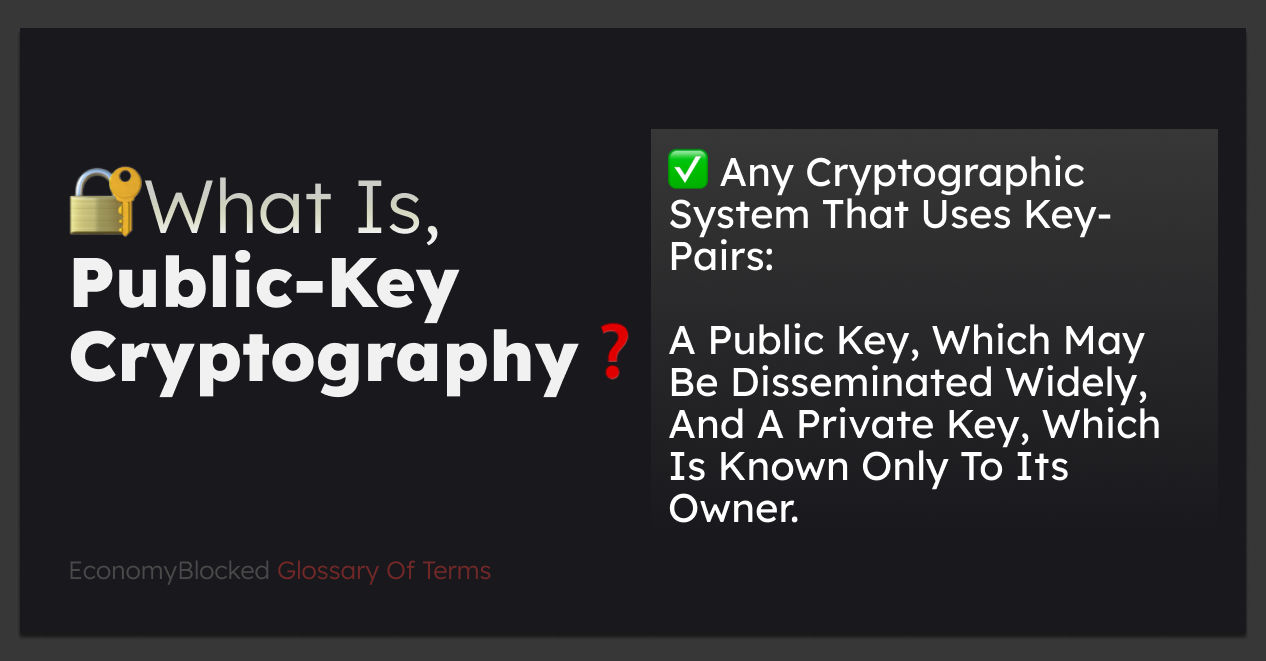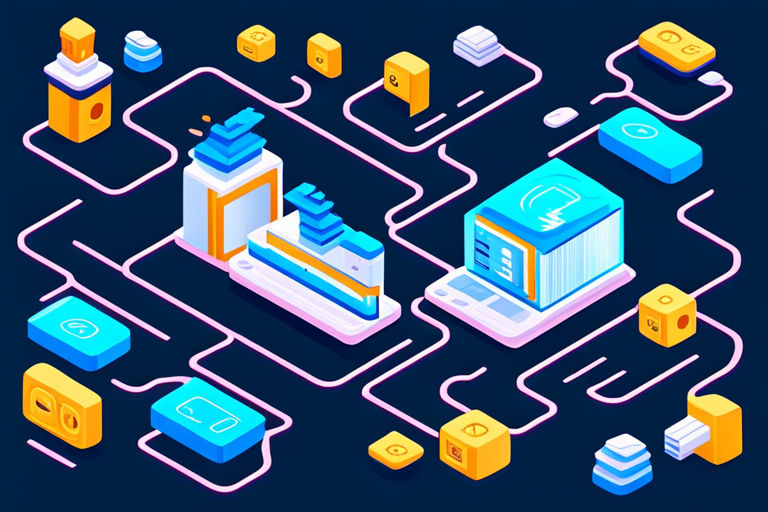📖 Glossary of terms

✅ Public-key cryptography, also known as asymmetrical cryptography, accomplishes two functions in a public-key encryption system: authentication or access control, which involves verifying that a holder of the paired private key sent a message using the public key, and encryption, whereby only the paired private key holder can decrypt the message encrypted with the public key.
The goal of both symmetric and asymmetric encryption is to scramble information so that only authorized users can encrypt information to be transmitted and decrypted to be viewed.
📦 The locked box analogy for public-key cryptography
This is analogous to a locked mailbox with two keys, one of which is freely given out, and the other of which is only known to the owner. Messages can be securely sent to the mailbox, and the recipient can use their private key to open it, but nobody else can open it without the key.
🧩 Topics Covered:
👉 Post Objectives:
Exactly what is public-key cryptography? This post, part of the economy-blocked glossary of terms initiative, explains what public-key cryptography is, as well as public and private keys, algorithms, and digital signatures. Besides the core use cases being reviewed, we also discuss what DSS is, how Blockchain uses public-key cryptography, how encryption is used in our everyday lives, and conclude with a discussion of some of the early developments in crypto security technology that led to the development of public-key cryptography. Additionally, we discuss how cryptography was once considered a military weapon and a highly-guarded state secret.
Public-key cryptography ; Private key ; Cryptography ; Encryption ; Digital signature ; Blockchain digital signatures

🗝️ What is a Private key?
In the context of decentralized ledger technologies (DLT), a secret key is essentially an encrypted password for someone’s crypto holding. It’s an impossibly long number that’s practically impossible to decipher, but as a key distinction, this same logic can be applied to any process in which public/private keys are used. Private keys are used to authorize transactions. Crypto assets, secure emails, documents, and other information can be accessed and managed with private-key cryptography using key-pairs – The length of a private key is typically between 256 and 4,096 bits, which we’ll be unpacking a bit more throught this post.
🔑 What is a Public key?
Again, using blockchain as a reference point, the public-facing address of your crypto wallet. To receive funds into your account, you must share your public key. In theory, each public key pairs with a private key, and the private key is only known to that user. A person has two public keys and one private key.
♾️ Public-key cryptography: Algorithms
By far, the RSA algorithm is the most popular public key algorithm used for digital signatures and data encryption. Secure communications, digital signatures, and data encryption are all enabled by RSA’s public key algorithm. The difficulty of factoring large numbers makes it a secure and reliable method for encrypting data.
A number of public-key encryption algorithms are available, including Elliptic Curve Cryptography (ECC), Diffie-Hellman (DH), Advanced Encryption Standard (AES), and Digital Signature Algorithm (DSA).
✍ Public-key cryptography: Digital Signatures
Written signatures have been used for hundreds of years to authenticate documents from financial transactions to promissory notes. The transition from analog to digital documents required new technologies and procedures.
“Just as written signatures tie a person to a particular document, digital signatures cryptographically link an identity to a message.”
A digital signature authenticates and verifies the identity of the sender of a message, document, or transaction. Public-key cryptography is used to generate unique digital signatures for each transaction that can be used to verify the sender’s authenticity. A digital signature can be used to sign or authenticate emails, documents, contracts, financial transactions, etc.
A digital signature is based on number theory, making it extremely hard to forge, which makes it a reliable way to authenticate a document.
📝 What is DSS Digital Signature Standard?
(DSS) stands for Digital Signature Standard, which is a United States standard for digital signatures that the National Security Agency developed to authenticate electronic documents.
“This Standard defines methods for digital signature generation that can be used for the protection of binary data (commonly called a message), and for the verification and validation of those digital signatures. Three techniques are approved.”

⛓️ Blockchain digital signatures
Digital signatures use public-key cryptography to generate a unique signature based on the contents of the message being signed. This signature is then used to verify the authenticity and integrity of the data stored on the ledger, ensuring that it has not been tampered with or altered in any way. The global digital signature market is expected to reach USD 48.4 billion by 2030,at a CAGR of 35.1% during the forecast period, 2023-2030
🔗 How does blockchain use Public-key cryptography
Public-key cryptography is one component that allows cryptocurrencies like BTC to be technically feasible. BTC used ECDSA to generate a set of private keys and corresponding public keys. This allows for the transaction to be processed on the public ledger ( the network itself), without an imposter having the ability to intercept or refuse said transaction.
Using a hash function, a public address that the BTC network uses to send/receive messages - The private key is then used to sign the digital transaction to ensure the efficacy and legitimacy of the origin.
🛡️ What is a cryptographic hash function?
In cryptography, a hash function produces a short, fixed-length string of output from a piece of data as input. Many cryptographic operations, including blockchain networks and encryption algorithms, use SHA-256 cryptographic hash functions. An output of 256 bits is produced by this one-way hash function.
🗂️ How crypto wallets use public-key cryptography
Crypto wallets use a public key for the wallet address and a private key for accessing the crypto. To send crypto to your wallet via your public address or public key, you can send your public key to a friend. Transactions are validated using the same elliptic curve algorithm for Bitcoin and Ethereum wallets.
🔢 Encryption in our day-to-day lives
In our everyday lives, we use encryption/decryption when accessing resources over the web, as well as when logging in to our iPhones using FaceID biometric encryption. In our world today, for instance, we increasingly send encoded data, which can be transmitted to someone, decrypted, and then analyzed, without an intermediary having access to the data or information being transmitted, thereby enabling a secure connection between two participants, nodes, or endpoints.
🔰 Cryptography as a military munition
In the 1970s, it was illegal for anyone to export cryptography IP outside the US, as anything exceeding 40 bits was considered a state IP secrete, comparable to military munition, as cryptography was only widely used by military institutions such as the NSA and CIA, before HTTPS and SSL encryption technologies became widespread encryption protocols for the internet.

👩🎤 The Cypherpunks and cryptography
The cipher punk movement of the 1980s advocated the use of cryptography in order to ensure the security and anonymity of Internet users and the sovereignty of the Internet. Due to increasing censorship by political groups pushing their incentives and narratives, both financially and sociologically, it became increasingly apparent that a sovereign Internet was the only solution as private institutions gained increasing control over our information in centralized servers. Cryptography pioneers identified this pain point in the 1980s, which highlights many of the core value propositions of networks like Bitcoin and Ethereum.
🎖️ 🌐 Final Thoughts
Public-key cryptography is an essential component of both the modern web as well as web3 and blockchain in general. In the last few decades, cryptography has become an integral part of our society and our economy, which was once considered a state secret. Often, military inventions and innovations serve as the basis or jumping-off point for many of the technologies and innovations we have today, from nuclear energy to the internet.
The purpose of this piece, which is a part of the economy-blocked glossary of terms initiative, is to explain what public-key cryptography is, including many associated terms and terminologies, such as algorithms and digital signatures used in public-key cryptography. We spent time unpacking what DSS is, how blockchain uses public-key cryptography, how we use encryption in our day-to-day lives outside of the core use cases being reviewed and concluded by reviewing cryptography as a military munition by examining some of the more early-stage innovations in crypto-security technology, which contributed to public-key cryptography development, as well as a the Cypherpunks and cryptography.
👾 More Recent-Posts
-
Bitcoin (BTC) Revolution: Catalyst, History, and Analysis
The main goal of this piece is to gain a deeper understanding of the reasoning behind the creation of Bitcoin, allowing for a more comprehensive perspective on its future
-
Macro & Geopolotics Report: 2023 Business Trends Report
In this post, we discuss macroeconomics, as well as geopolitics as part of the 2023 Business Trends Report 🌍
-
💲NEAR Protocol: Overview and Price Prediction
In this article, we will be conducting an extensive analysis of the 💲NEAR protocol, which is the platform I have the most experience building dApps on, as a Product Manager in web3
-
8 Healthcare Industry Trends and Innovations
In this post, we will be reviewing 8 business trends for the healthcare industry, including each of it's sub-industries, such as MedTech🔬
-
Cardano(ADA) Overview and Price Prediction
As a part of this post, we'll be reviewing what Cardano (ADA) is, its benefits, Tokenomics, a price prediction model, and the future of its fledgling ecosystem 💱
-
Ruby on Rails and The Future Of MVC
Discover the amazing potential of Ruby on Rails! Learn about its history and design philosophy, why it's the perfect choice for web development, and how to get started with the framework ♦️
-
Artificial Intelligence: Business Trends Report
Large language and generative models are reaching a point of emotional realness that they can no longer be distinguished from humans 🚀
-
2023 Geopolitics Report
A guide to help both businesses and product managers use geopolitics as a strategic advantage in 2023
-
Post-Industrial Digital Banking
Explore the post-industrial era of digital banking. Deployment-based market research, post-industrial hypothesis validation,opportunities,and more 📲
-
How 👾 (AI) Will Transform Product Management
In this post, we will unpack how (AI) will transform aspects of product management, as well as it's impact across cross-functinoal teams 🎖️
-
2023 Transportation Industry Trends 🚊
In this post, we will be covering 2023 Transportation Industry Trends, including market research, business strategy, and more... 🚉
-
Energy Sector Forecast 2023 ⚡
The 2023 Business Trends Report covers sector-based projections, major innovations, market dynamics, opportunities, and technologies by sector or industry - this post covers both traditional and renewable energy markets 📈
-
To-Blog Or Not-To Blog❓ | 2023 Blog Launch Helper |
This post is designed to help you or your team launch and optimize a successful blog by examining why businesses blog, providing a blog business plan guide, exploring SEO and analytics tools, and an overview of blogging platforms and frameworks
-
Make the web fast again | What is a CDN❓| How do CDNs work❓
In this post, we review what a CDN is, how they work, the business of cdns, as well as some of the best options to consider when choosing a cdn
-
We're In Way Over Our Heads | Going Headless (CMS)
Content is king! In this post we review Headless-CMS, content management systems; How they work, an overview of JAMstack, some of the best options, etc, will be discuessed
-
Building Static Websites In An Un-Static-World (SSGs)
In this post we'll be reviewing (SSGs) static site generators, reviewing the tech as a means of providing value to your next project or business during times of uncertainty– The advantages, how they work, and evaluating frameworks, including Jekyll, Hugo, and Gatsby. JS, etc 🛠
-
How (AI) is changing the way we work
In this post, we'll explore two use cases for (AI) ⚔️ (AI) Writing and Text-To-Image (Generative-AI) – How they work, as well as their current and future, use cases for the workplace, as well as available tools and services
-
Industrial Revolutions
Part-1 (1-2 IR) This is the first post of the Industrial Revolution series, covering the 1st and 2nd Industrial Revolutions, major tech innovations and advancements during each period
-
Industrial Revolutions
Part-2 (3-4 IR) This is the second and final post of the Industrial Revolutions series, covering the 3rd and 4th Industrial Revolutions. Focusing on the tech and innovations during this period
-
Tokenomics
Ledgers and Accounting represent two foundational aspects of tokenomics and token-engineering, this is the first of many post where I will be covering tokenomics, focusing on presenting my research and aspects of system design
-
Fintech Deep-dive
How the tech industry is changing finance: This post outlines the history of financial technology (FinTech) and major innovations, as well as companies at the forefront of this sector
-
Web 3 Systemic Issues Report
In this post I review some of the most systemic-issues that I have identifed after contributing to a few web3 startups in varying levels of involvement – please take what is stated as speculative conjecture, nothing more 🙏